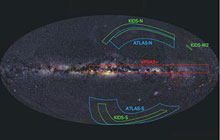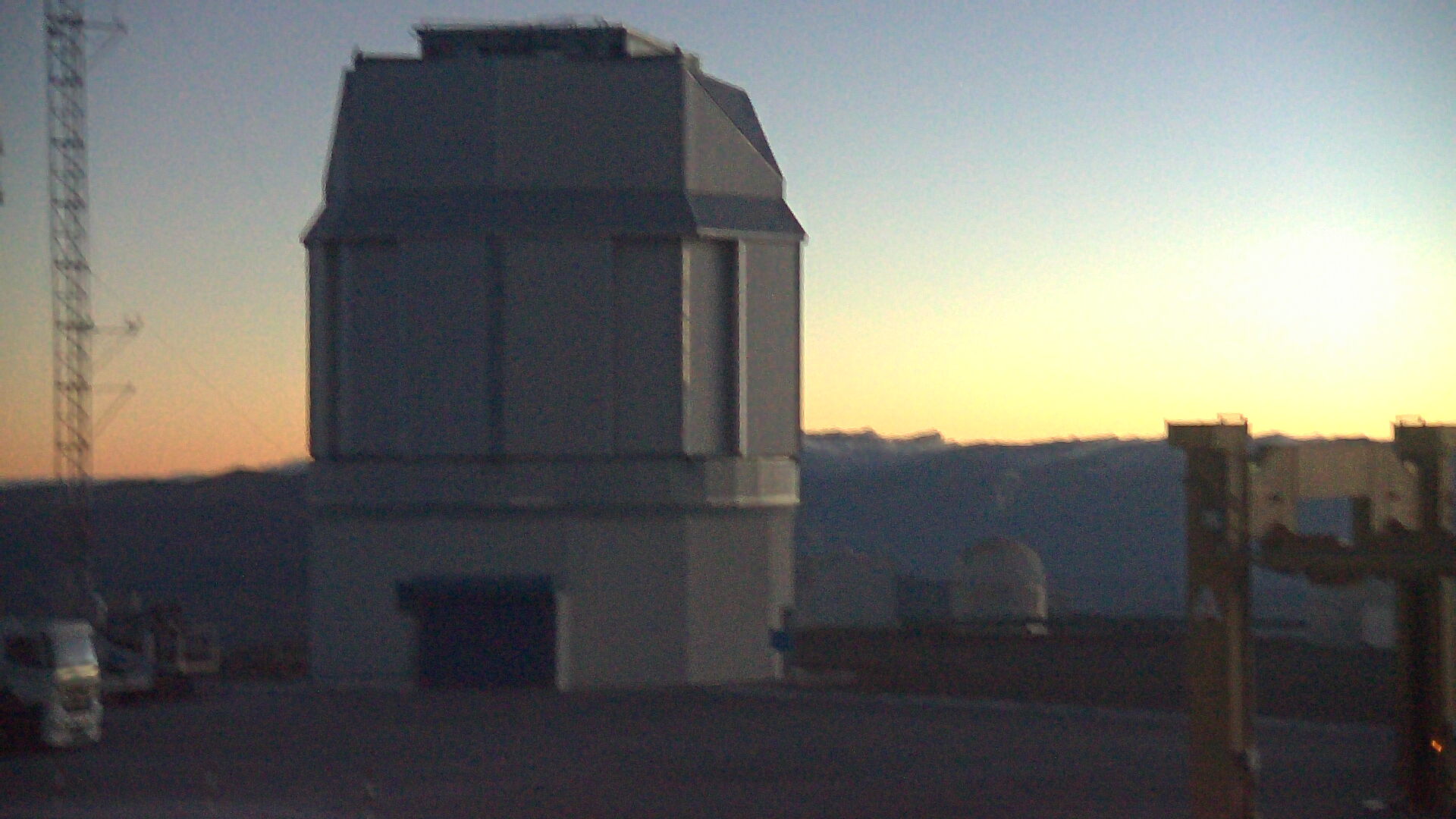VST (VLT Survey Telescope)
Il VST (VLT Survey Telescope) è l'ultimo grande telescopio installato all'Osservatorio del Paranal dell'ESO (eso1119). È tra i più grandi telescopi al mondo progettati per le survey del cielo in luce visibile. Questo telescopio modernissimo, di 2,6 metri di diametro, accompagna il VLT dell'ESO sul Cerro Paranal, un'ubicazione perfetta per osservazioni astronomiche da terra. Ha in dotazione OmegaCAM, una gigantesca fotocamera da 268 megapixel, erede del WFI (Wide Field Imager) di gran successo installato sul telescopio da 2,2 m dell'MPG/ESO a La Silla.
Come il VLT, il VST copre un'ampio intervallo di lunghezze d'onda, dall'ultravioletto all'ottico e al vicino infrarosso (da 0,3 a 1,0 micron). Ma mentre i telescopi più grandi, come il VLT, possono studiare solo una piccola zona di cielo per volta, il VST è progettato per fotografare grandi aree velocemente e in profondità.
Con un campo di vista di 1°x 1°, largo il doppio della dimensione apparente della Luna piena, il VST da anche supporto al VLT producendo immagini grandangolari che permetto di rivelare e caratterizzare le sorgenti che verranno poi studiate in dettaglio dai telescopi principali (UT) del VLT.
Il VST ha due specchi, il primario (M1) con un diametro di 2,61 m e un secondario più piccolo (M2) con un diametro di 93,8 cm. Il telescopio è equipaggiato con un singolo strumento apposito nel piano focale: OmegaCam. Questa enorme fotocamera a CCD (da 16k x 16k pixel) è stata costruita da un consorzio internazionale di cinque istituzioni: NOVA (Netherlands Research School for Astronomy), l'Istituto Astronomico Kapteyn, l'Universitäts-Sternwarte München, l'INAF-Osservatorio Astronomico di Padova e l'ESO.
Scienza con il VST
 Il VST è dedicato ai programmi di survey. Con la sua fotocamera all'avanguardia, la qualità delle ottiche e le condizioni eccezionali di seeing al Paranal, il VST sta facendo scoperte importanti in molte aree di astrofisica e cosmologia. Nelle scienze planetarie, il telescopio per survey mira a studiare i corpi remoti del Sistema Solare come gli oggetti Trans-Nettuniani, oltre a cercare i transiti di pianeti extrasolari. Il piano galattico viene osservato ampiamente per fornire agli astronomi dati cruciali per la comprensione della struttura e dell'evoluzione della nostra Galassia. Ancora più lontano, il VST esplora le galassie vicine, le nebulose planetarie extragalattiche e intra-ammasso, oltre a ricercare eventi di micro-lente e studiare oggetti molto deboli. Nel campo della cosmologia, il VST studia le supernove a redshift intermedio per meglio fissare la scala delle distanze cosmiche e comprendere l'espansione dell'Universo. Il VST cerca anche strutture cosmiche a redshift medio-alto, nuclei galattici attivi e quasar per migliorare la nostra comprensione della formazione delle galassie e della storia primordiale dell'Universo.
Il VST è dedicato ai programmi di survey. Con la sua fotocamera all'avanguardia, la qualità delle ottiche e le condizioni eccezionali di seeing al Paranal, il VST sta facendo scoperte importanti in molte aree di astrofisica e cosmologia. Nelle scienze planetarie, il telescopio per survey mira a studiare i corpi remoti del Sistema Solare come gli oggetti Trans-Nettuniani, oltre a cercare i transiti di pianeti extrasolari. Il piano galattico viene osservato ampiamente per fornire agli astronomi dati cruciali per la comprensione della struttura e dell'evoluzione della nostra Galassia. Ancora più lontano, il VST esplora le galassie vicine, le nebulose planetarie extragalattiche e intra-ammasso, oltre a ricercare eventi di micro-lente e studiare oggetti molto deboli. Nel campo della cosmologia, il VST studia le supernove a redshift intermedio per meglio fissare la scala delle distanze cosmiche e comprendere l'espansione dell'Universo. Il VST cerca anche strutture cosmiche a redshift medio-alto, nuclei galattici attivi e quasar per migliorare la nostra comprensione della formazione delle galassie e della storia primordiale dell'Universo.
Il VST è il risultato di una joint venture fra l'ESO e l'Osservatorio Astronomico di Capodimonte (OAC) di Napoli, un centro di ricerca dell'Istituto Nazionale Italiano per l'Astrofisica (INAF). Il centro italiano ha progettato il telescopio, mentre l'ESO è responsabile per i lavori di ingegneria civile al sito.
Il VST è divenuto operativo nel 2011.
Scopi scientifici
Dedicato alle survey. Via Lattea, nebulose planetarie extragalattiche, cosmologia.
Ulteriori informazioni sul VST
- Lo specchio del VST
- La fotocamera del VST
- Le survey con VST
- Per i ricercatori: I dettagli per gli osservatori che usano il VST sono disponibili qui: Pagina di OmegaCAM al VST
Immagine dal vivo
Segui il VST per mezzo di questa immagine in diretta, aggiornata ogni ora durante il dì. Si ingrandisce con un click sull'immagine.
VST
|
|
Lo sapevate?
Le stelle si formano all'interno di dense nubi di materiale interstellare, ma anche in queste regioni densissime la pressione è pari al più tenue stato di vuoto che riusciamo a creare in un laboratorio sulla Terra. In queste nubi, le temperature non superano i -200 gradi Celsius. Did you know?
The annual ESO member state contributions are equivalent to less than 35 euro cents per person. Lo sapevate?
L'osservatorio del Paranal è così remoto che tutto dev'essere portato appositamente. I 60 000 litri d'acqua che vengono utilizzati ogni giorno vengono portati con cisterne da Antofagasa. |

